| The Palm m505 |
 |
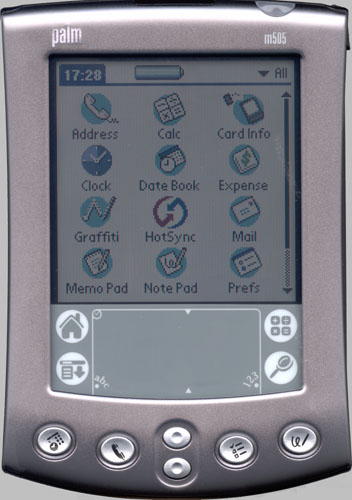 . . |
.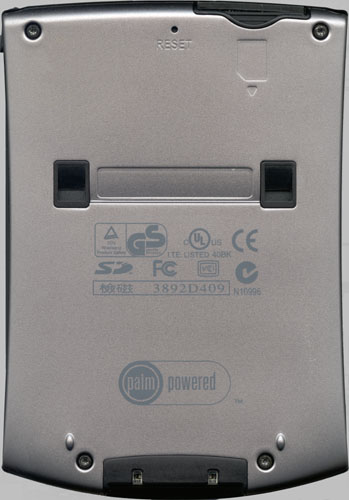 |
|
|
| .
What else is different on the first sight? The power switch is where the PalmV has it, but on the m505 it's made of transparent plastic and can be illuminated with a green LED underneath. The green light is used either when the internal battery is charged (or rather when an external power supply is available, since it doesn't go off when the battery is full), or it can be used as a silent alarm indicator. The latter one is a new feature of the m505. On the back, there are two larger plastic dents which prepare the m505 to lock on accessories which are coming in cases similar to the PalmV modem, going behind the handheld. On the back you'll also find the access to the new SD-Card slot. More about that a bit later. Oh yes, how could I forget the most important detail on the m505: It comes with a transreflective color LCD, capable of displaying 65K colors. But more about the screen in its own section. And a last detail that will cause some discussions and rants again. The m505 has yet another serial connector than all other Palms so far. In fact it's called universal connector meanwhile and indeed, that names describes it better. Basically the changes of the connectors are a big annoyance and Palm arouses the suspicion, they could have a secret alliance with the accessory industry. But in case of the m505 the change makes sense, since for the first time there are quite a few new functions. Hopefully Palm didn't wear out all the acceptance of their users with the previous, pure mechanical variations of the same old hotsync connector. Anyway, the m505 connector has 16 pins and they are all but one necessary, to support all functions. The reward is a serial port in full compliance with the RS-232 standard and a USB port, plus some more new signals that make alot of sense. . But Palm added also some invisible goodies. Coming with the brandnew OS 4.0 and a faster CPU, the m505 is above all very 'snappy'! The screen redraw and swapping applications was never that fast. Another highlight for a PDA is the built-in vibration alarm, together with the green light in the power button another possibility for a silent alarm. The vibration alarm makes alot of sense in a Palm. First of all for the obvious reason of sparing some nerves, but also to make sure not to miss important alarms. Since the Palm's audible alarm was never the loudest, the vibration is a very good alternative. BTW, that gets me to the traditional part: The sound device in the m505 is still the same lousy piezo, preventing as ever more sophisticated sound applications. Well, that's evolution ... maybe next time. . |
 . . |
.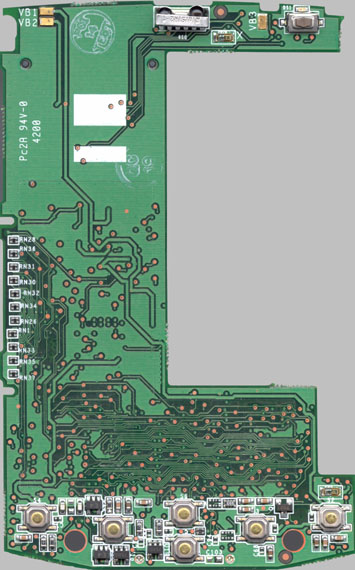 |
| .
A real surprise and a valuable addition to the m505 hardware concept, is the dedicated display controller from Epson. So far, all Palm models used the embedded LCD port of the Dragonball CPU. That's the cheapest way to control the LCD and after all the Dragonball is meant to be used like that. The big disadvantage of this concept is, that the system RAM has to be shared between regular, programmed accesses to the data and the DMA like access for the LCD refresh. The Epson controller is by far no PC 3D-graphic card super chip, but already its 80kB of own display buffer is a treasure and improves the system performance. It also allows appropriate refresh rates without any speed penalty. There's another nice feature build into the conroller. It can rotate the image 90, 180 or 270 degrees by hardware. A document reader could take advantage of this feature, though, it still had to check the orientation if there are any soft buttons on the screen. . Another new intelligent chip on the m505 board is the USB controller from Philips. The chip is quite complex and in this review I can't say much more, that it's basically adding all the USB funtionality. If you really want to know all about the capabilities of the PDIUSBD12, it would be good to study the datasheet from Philips . The controller implements USB v1.1 and according to the datasheet is has a max. transfer rate of 1MByte/sec. That opens complete new applications for the m505, hopefully the accessory industrie is already busy with it. Digital imaging, mass storages, scanner, printer, well, all the USB stuff could be adapted now. And the USB adds basically a second hardware port. Finally a keyboard could be hooked up to the m505 while it's online at the same time. Currently Palm is only offering a USB cradle for faster hotsyncs, but I bet there'll be more soon. . And of course there's the SD-Card slot which takes up quite a bit of space on the m505 board. The slot is compatible with the MMC (MultiMediaCard) which is already widely in use for portable MP3 players. True SD-Cards are still rare, but that's not such a pity for the user. The main purpose of the SD standard is to protect intellectual property, since it comes with an encryption 'intelligence' built into the card. As a kind of external memory expansion, or to backup data from the internal, volatile memory, the MMC is as good as the SDC. The mechanical make of the slot is quite nice and works 'ballpen-like'. You push the card in until you feel a click and the card is locked. Push again, and the card comes out about 10 mm above the case. No need to 'fish' for it. The slot supplies a card-in signal which tells the OS a card has been inserted or removed. More about that in the OS section. . |
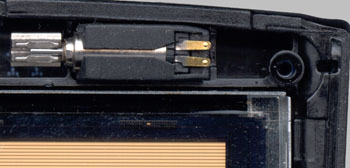 . . |
. |
| .
The image above shows the motor for the vibration alarm. The m505 uses the same type of motor you can find in the smaller mobile phones, no real news here. But the size is still impressing and it's hard to believe such a tiny motor can move anything, let alone shaking a complete Palm. Well shaking would be probably a bit of an exaggeration. But the m505 produces a respectable hum that's clearly feelable. As mentioned in the introduction, the vibration alarm is one of two silent alarm options. All three alarm options (piezo, light, vibration) can be enabled or disabled separately. Unfortunately the vibration alarm duration is a bit too short, but some third-party alarm tools will fix that. . |
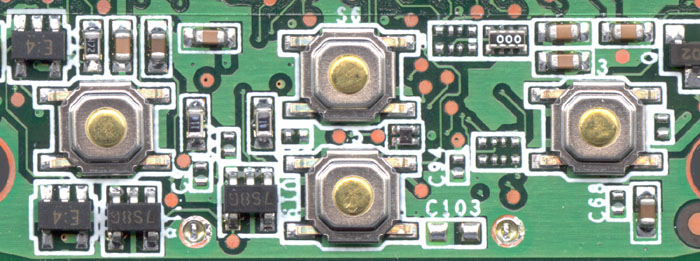 |
| .
Great to see, that Palm finally realized that good quality buttons are an indispensable detail. The Palm IIIc was the last example for a 'self-made' key, a lot of users had problems with. The m505 uses standard, industrial micro switches and consequently, the feel of the application buttons, the scroll buttons and the power button is excellent. Just the right force and still 'touchy'. The bigger scroll 'teeter-totter' of the PalmV is gone, the m505 has two little, separate scroll button. I personally liked the PalmV solution better. But I read quite a bit on my Palm and I used the scroll buttons on my PalmV in a very special way - kind of sideways with my thumb. That works better when the button is bigger. The advantage of the new design is, that the protection leather flap can't push the smaller buttons anymore. BTW, there is another advantage of the new micro switches. They are a standard type and in case you still happen to ruin one of them, at least us hobbyists (or a friend who is one) could change it ourselves. On my 'all-day' PalmV for example, the power key became a pain to operate and even I see little chances that I rip that glued PalmV apart. And $100 repair for a single button? No thanks! . |
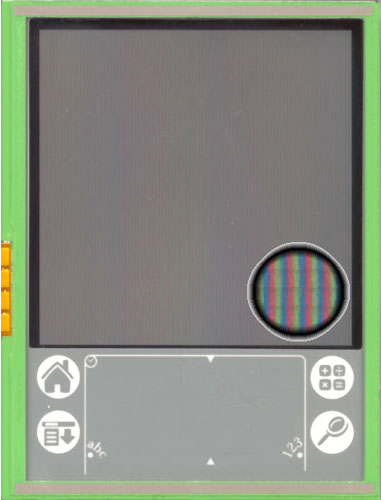 . . |
.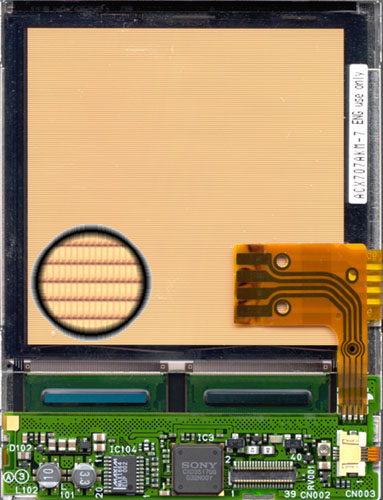 |
| .
The images above are showing both sides of the color LCD used in the first m505 I had for this review. It was produced in the USA and the LCD came from Sony. Menawhile I have a unit for my personal use which was produced in Hungary. In that m505 a screen from LG is used (it looks a bit different on the backside) and I have the impression, the Sony screen was slightly better (better contrast) - but I might be wrong, the difference is probably academical. The circles on the images are showing small magnified areas. The color image on the m505 is produces the same way a color TV does it. Each of the 160x160 pixels is made of 3 'sub-pixels', one red, one green and one blue. On the backside of the display, obviously each pixel has its own tiny micro-mirror to reflect the incoming light. The active backlight is paperwhite and helps to read the screen much better already on normal office light conditions. Only in very bright daylight and sunlight the backlight is basically invisible. . But back to the display quality. As mentioned already, the colors are not as vivid as on a throughlight LCD, but for a PDA the unrestricted outdoor use is much more important. Additionally, the sharpness and the contrast ratio improved alot over the monochrome Palms. Reading for example an ebook on the m505 is a pleasure. BTW, in numbers the m505 has a contrast ration of 20:1, while a Palm V or the new m500 have only a contrast of 10:1. Another great improvement is the readability in dim light. The m505 display doesn't show the strange inverted backlight effect of the monochrome Palms. There are no more situations like 'too dark without' and 'still too bright with' the backlight. The screen is absolutely 'streak-free' and there are no user settings for contrast or brightness. But there is a kind of black-level setting, a little potentiometer on the backside of the display (lower/right corner on the image, more towards the middle on the LG display. But there is only one). I found out, that I could improve the display on my 'Hungarian' Palm a bit, the display came presetted too dark. But be warned, it's a tricky process. The biggest problem is, that you can hardly reach the pot if the Palm is assembled enough to work. And only then you can control the result. Then you have to find a fitting screwdriver. DON'T use a wrong one and try to compensate fit with fiddling or pressure on the pot! Once you're ready to go, try to find the point, where the white background on the active area is just as white as the few pixels of inactive area around the screen (the screen seems to have 164x164 pixels, but the 2 pixel border is never active). If the active area is 'grayer', you loose contrast. If you turn it too far into the white, you loose 'blackness' on the black pixels. . Oh, there's another nice new detail. The graffiti area on the m505 is also slightly illuminated when the backlight is on, making the graffiti area clearly visible in the dark. BTW, that's an m505 feature only, the new m500 graffiti area is not illuminated! . |
| The digitizer is an inseparable part of the screen and not all Palm
models had equally good digitizers in the past. Especially on a Palm IIIc
stylus operations can degenerate more into a stunt. IMHO it needs much
too much force. Paired with the natural slowness of the Palm IIIc, graffiti
input on a IIIc is no real fun. Exactly the opposite on the m505! The digitizer
is accurate and easy to operate. Paired with the fast CPU, taps and graffiti
inputs are just great. Even after years of using a Palm now, I had the
impression that my graffiti error rate improved only by using the m505.
Paired with the snappy screen refresh I would clearly rate the m505 by
far as the best to handle Palm. One of my favourite games is still 'Patience'
from Keith Packard, version 1997, and it's pure joy to run this tap-intensive
app on the m505.
. |
 |
| .
You can find the pinout and a short explanation of the signals in the table below. Beside the new USB funtion, the most interesting pins are the VOUT and the ID pin. The m505 is finally the first Palm that officially supplies power to external peripherials. External accessories can be build smaller and after all, why paying for extra batteries if you have a rechargeable battery already. Additionally, whenever I grabbed my PalmV modem every once a while, the batteries were empty for sure. However, the VOUT pin supplies regulated 3.2V and a max. current of 100mA. Considering modern electronics, that's quite a lot (far more than the m505 needs itself). Peripherials with a higher consumption would drain the internal battery anyway much too fast. ATTENTION: VOUT is equipped with an internal 250mA SMT soldered fuse! If it's blown, it has to be replaced. So if you don't own an SMT workplace and the appropriate skill, you better don't fiddle with that pin. Let alone purchasing the fitting fuse (case 0603, Littlefuse). The ID pin enables a peripherial device to identify itself and I would guess, the new OS 4 reacts accordingly (didn't test it yet). Depending on the resistance to GND, external devices can identify themselves as a USB cradle, an RS-232 cradle, a USB peripherial, an RS-232 periapherial or as a modem. All other pins are known from several other Palm models and are working accordingly. . |
|
.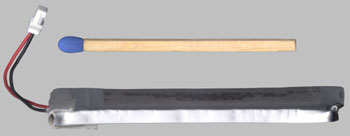 |
| .
The little guy supplies an energy of nearly 2Wh, that's about 40% more than for example 2 NiMH AAA batteries. And the NiMHs would weight over 50% more! The energy gain is very welcome for the m505 since it definitely consumes quite a bit more. In idle mode (on, no action, no backlight) the PalmVx needed about 16mA, the m505 consumes 23mA. With backlight the consume jumps up to 65mA, the PalmVx needed 45mA. Considering the fast CPU and the stronger backlight for the color screen, the consumption gain is still ok and the LiIon Polymer battery compensates it. You might say, hey, 23mA times 20 hrs doesn't give 540mAh, were is the rest? Don't forget, the m505 has to keep enough power for data retension. Like all rechargeable Palms, the m505 has no additional backup source. The warning level on the m505 is set to 3.76V, the critical level is 3.72V. Below the critical level the m505 doesn't power on anymore. Down to 3.6V the battery supplies only the internal RAM then. All in all, the m505 should have about the same operation times than a PalmVx. Only the backlight of the m505 eats a bit more. Tests revealed a continous working time of about 20 hrs without and good 6.5 hrs with backlight. That's very good for a small color PDA. However, games that make heavy use of the CPU will further reduce the operation time - and there are already quite a few good color games on the market! . Fortunately Palm also found the space to fit the complete charge logic in the unit. Like the PalmIIIc, the m505 needs only stabilized 5V (up to 700mA) to be charged. The PalmVx still used a dedicated external LiIon charger supplying the right current/voltage regulation. Sure, it came with the PalmVx, but foreign buyers sometimes couldn't use it because of the 115/230V crap in our world and on the road a relatively expensive travel charger had to be used. With a little luck and the right adapter (self made), you might be able to use your mobile supply in the car to charge also your m505. Alot of mobiles use external 5V supplies and most of the cigarette plug style adapters are able to supply 1A, more than enough. A little warning here: If you intend to use a replacement for the original 5V supply from Palm, make sure it's truly regulated! There are good regulated wall bricks on the market for as much as $10-$20, they'll do it. Don't use the usual $5 '3-6-9-12V' supplies!! They are most likely not regulated and the output voltage is varying strongly with the output load. But a LiIon battery is not charged with a constant current, but with a constant voltage (along with a current limit if necessary). In other words, when the LiIon battery is quite empty, the charge current might be as high as 300-500mA and the voltage of the cheap brick is right. Later, when the battery becomes full the current drops below 10mA and the voltage would rise above a healthy level, due to the missing load. So better spend a few $$$ more! Recharging the m505 works quickly. A full recharge cycle takes only about 90 minutes, but due to the charge characteristic of LiIon batteries, 80% of the charging is already done after 40 minutes. Unfortunatey the m505 comes with the same 'crippled' charge control LED as the PalmVx. Instead of going off when the battery is full (which the PalmIIIc charge LED did!), the illuminated power button of the m505 just shows the existance of external charge power. Additionally, the battery symbol shows only the flash symbol which is static. IMHO a rather big flaw, that you have to remove the m505 from the cradle to check the battery status. Hint: Palm, just look at ANY mobile phone on the market - even the cheapest ones are giving you an idea of how your battery is doing while it's recharged! . |
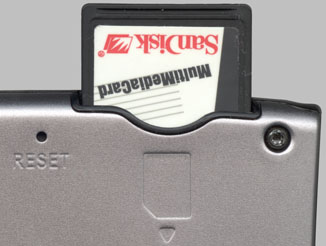 . . |
.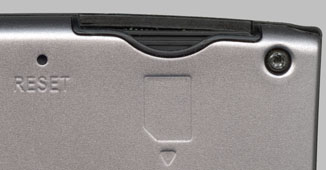 |
|
|
| However, the m505 places its bet on the SD-Card and considering the
size of the unit, it was the right decision. The SD-Card is basically the
next generation of the Multi Media Card, which is already widely used in
portable MP3 players. The SD-Card standard is downward compatible to the
MMC, so MM-Cards are working well in the m505. If you boil it down to the
facts, the SD-Card was anyway more invented for the content providers than
for the users. With its additional embedded security features it is supposed
to protect its preloaded content like ebooks or applications. Used as a
flash memory expansion for own data, prepaid ebooks, map data etc, both
standards are equally good. And while Palm wants nearly $40 for a 8MB SD-Card
with a backup program, you can get for nearly the same money a 4 times
larger 32MB MMC for a much more versatile use. Add $9.95 for HandEra's
DataPro and you have real neat solution (automatic, timed backup etc.).
The new OS 4.0 supports the card fairly, but don't expect any magic. Most of the functionality is hidden support for applications that make use of the card slot. The only supplied application in ROM is CardInfo. CardInfo just shows a few informations about the inserted card and you can rename and format a card with it. The Launcher in OS 4.0 however allows to copy applications back and forth, unfortunately there's no onboard tool to copy also databases. It would have been nice to have all card functions in one place, either in card info or in the Launcher menu. And copying, moving etc. _everthing_ on a computer, apps as well as databases, are basic funtions of an OS! When a card is inserted, the Launcher switches automatically to a category that carries the volume name of the card. BTW, the cards can be formatted and prewritten perfectly under DOS (Windows) with the usual USB-MMC readers. Transferring alot of data for card enabled Palm applications is much quicker that way than to hotsync it to the card. When the card is removed, the category disappears again and the Launcher switches to the category ALL. It would be much nicer if the OS would remember the last used category. It would be anyway a good idea, to make that category thing selectable. If you only have data stored on the card, there is no point to switch always to the card category first. Especially if you had the application that uses the card data already visible in a category in RAM. That a bit annoying. My impression is, that the OS is supporting the card slot on a very low level, which actually is ok for an OS. Future third party tools and apps will have to improve the handling and for sure they'll make use of the gained memory space. . |
| A real nice one is the new reminder for unconfirmed datebook alarms.
So far, all old unconfirmed alarms had to clicked away one after each other
and then they were gone. OS 4.0 builds a list of unconfirmed events. As
long as there's an unconfirmed entry in this list, a star is blinking in
the upper right corner of the screen. The nifty detail only an OS can do,
that star is blinking always in the corner, no matter what application
is running. Tapping on the star brings up the event list, also from any
running application.
. There's probably more in the new OS which I might have overseen so far, but in the end I wanted to mention another time the snappyness of the new package OS 4.0, m505. It's really fun to work with it. Basically all taps on the screen are delayfree and as mentioned above, the Graffiti recognition improve. At least my error rate went down ... . |
|
This and that . As always I needed that section to mention all the little things I couldn't fit in any other category. The stylus slots for example. Working quite soft, it's absolutely mysterious why the left slot, the one for the leather flap, is a few mm thinner than the right one. The stylus doesn't fit there anymore, lefthanders will be disappointed. And then the stylus itself. It looks exactly like the one of the PalmVx, but it is exactly 3mm shorter, a PalmVx stylus does not fit. 2/3 of the m505 stylus is equal, the tip and the shaft. Only the upper part is shorter! And since Palm saved the extra cheap plastic stylus that still came with the PalmVx, you have no extra. It might be tiny detail, but it annoys me anyway! . When I wrote this review, I had no m505 cradle yet. But meanwhile I tested also the m500 with cradle. Since the cradle is the same for both models, please read the facts about the cradle in the m500 review. . The m100 introduced that nice, convenient way to pop up the time for 2 seconds when the unit is off. Although there is a clock application in OS 4.0, the pop-up function is gone. Ok, the leather flap has no nifty window, but it would be a nice to have anyway. . Mail is back in ROM (had to be left out on the m100, there was no space), but IMHO its still crippled. I never understood the decision of Palm, to leave out that last little step to connect the rich connectivity possibilities of the Palm with the Mail application directly. Only the PC can fill the inbox with mail, not a modem or a mobile on the road. However, the good news are coming from Eudora. Their Internet Suite for the Palm Computing Platform is a great add on for the m505 (and other Palms) and the best of all, it's free! Eudora offers the only package consisting of email client and HTML browser that are aware of each other. Click on a link in an email and the browser jumps right to the location. The only drawback is, that the browser is not the greatest yet. Stable, but it doesn't display images and alot of HTML standards are missing. Hopefully Eudora keeps up improving it. But the email client alone is worth to get it. . |
|
Bottom line - The greatest Palm so far! It's a strong vote, but the m505 deserves it. Palm PDAs were never meant to be multimedia machines, nor is it the m505. But the market obviously appreciates the advantages of this concept for good reasons. I remember a wishlist that appeared not even 2 years ago in the newsgroups: A PDA not bigger or heavier than a PalmVx, same elegant style and the same battery operating time. But with a color screen and memory expansion possibilities. The usual answer was: Dream on! Now Palm did it. And they even added the vibration alarm and the USB port. And I mean added, since the full RS-232 port is still available, which is nice for less intelligent peripherials. The RS-232 port is still an important, universal connection. The reflective color screen is the best solution for an all-day PDA. It's equally good from total darkness to bright sunlight and the power consumption fits in the concept. And in case I didn't make that clear enough: Color is just more fun! There are already quite alot good color applications on the market which are demonstrating, that color expands the possibilities alot regarding the limited resolution of 160x160 pixels. People playing also games on their Palms will love the color screens. Just take a look at games like Bejeweled or ZAP!2000 and you'll know what I mean. But also 'serious' applications (no offense, I know that coding a good game is hard work!) benefit alot from the color LCD, like the outstanding Datebook 4 from Pimlico Software. And even if you only happen to read ebooks in black&white on your Palm you'll appreciate the clear, crisp display. The SD-Card slot is another big step forward for Palm. Even if alot of Palm applications could be fit into internal memory, database applications were limited so far. Now you can take virtually any database with you on the road, limited only by the number of SD- or MM-Cards you're willing to carry. The standard USB port fits well into that expansion. Hotsyncing two-digit Megbytes of data via the serial port would have been a pain. Even if the Palm USB port doesn't make use of the max. speed of USB, it speeds up the hotsync alot. Last but not least, the m505 represents another step towards the plan to merge PDAs and mobile phone, respectively mobile communication. Especially the new OS 4.0 is equipped with more communication routines and functions than ever. I wouldn't wonder if there is already some 'sleeping' Bluetooth support, after all Palm announced external Bluetooth hardware for the end of the year. I'm quite sure, it'll be only available for the m50x series. The Lithium Ion Polymer battery is a worthy power supply for the m505, giving it the usual 'Palm mobility'. The operation time of the m505 is probably the best you can get considering the color display and the given technology. . My last 2 cents: If you wanted to buy a color PDA and you're not shy of paying $500 - get an m505! If you loved your PalmVx and sweared you'll never give it up - get an m505. And if you own a PalmIIIc because you always wanted a color PDA - get an m505! . BTW, to begin with you can have a look at the m500-Series handbook here. . |
|
. Last updated: June 15th, 2001 Copyright © 1997-2001 by Peter Strobel, all rights reserved. |